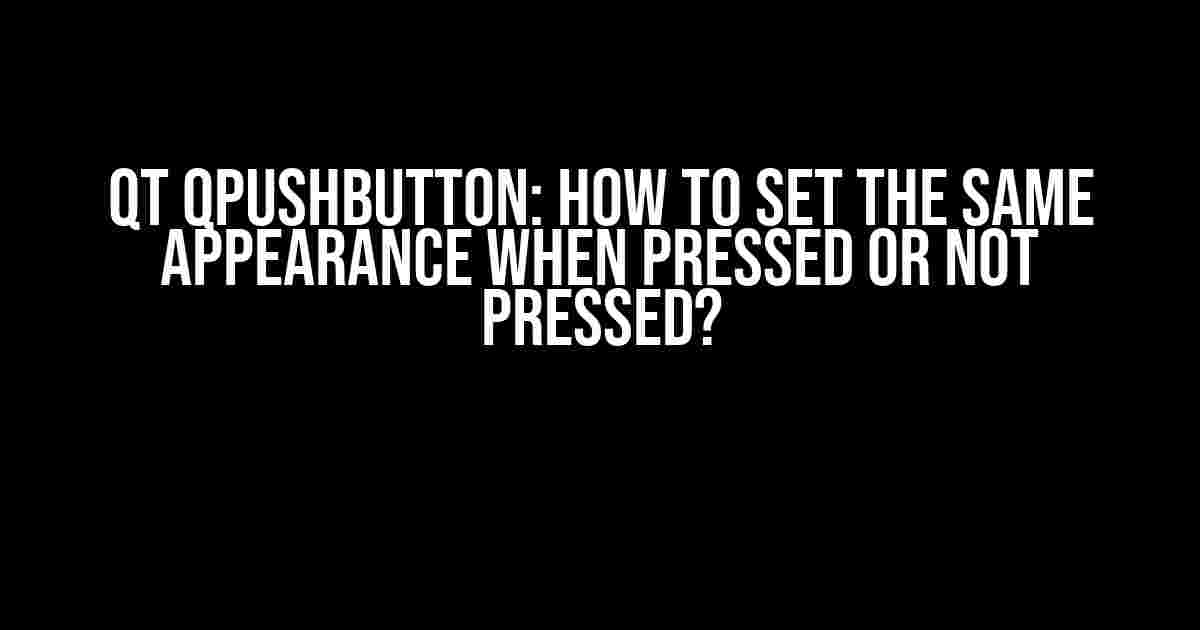Are you tired of dealing with the default QPushButton behavior where the button changes its appearance when pressed? Do you want to create a uniform look for your buttons, whether they’re pressed or not? Look no further! In this article, we’ll explore the world of Qt QPushButton and learn how to set the same appearance when pressed or not pressed.
Understanding the Default Behavior
By default, QPushButton changes its appearance when pressed. This is due to the internal implementation of the button’s style sheet. When a QPushButton is pressed, Qt sets the `:pressed` pseudo-state to `true`, which triggers the button’s style sheet to apply different styles, such as changing the background color, border, or text color.
QPushButton {
background-color: #CCCCCC; /* default background color */
border: 2px solid #AAAAAA; /* default border */
}
QPushButton:pressed {
background-color: #AAAAAA; /* pressed background color */
border: 2px solid #CCCCCC; /* pressed border */
}
As you can see, the default style sheet applies different styles to the button when it’s pressed. This is where we come in to change this behavior.
Method 1: Override the Style Sheet
One way to set the same appearance for the QPushButton when pressed or not pressed is to override the default style sheet. We can do this by creating a custom style sheet for our button.
QPushButton {
background-color: #CCCCCC; /* default background color */
border: 2px solid #AAAAAA; /* default border */
}
QPushButton:pressed {
background-color: #CCCCCC; /* same as default background color */
border: 2px solid #AAAAAA; /* same as default border */
}
In this example, we’ve overridden the default `:pressed` pseudo-state style sheet to match the default style. This will ensure that the button looks the same whether it’s pressed or not.
Pros and Cons
- Easy to implement
- Works for most cases
- Can be applied to individual buttons or globally to all QPushButton instances
- May not work as expected if the button has a complex style sheet
- Requires manual styling for each button property
Method 2: Use a Custom QPushButton Subclass
Another approach is to create a custom QPushButton subclass that ignores the `:pressed` pseudo-state. This method provides more control over the button’s behavior and appearance.
#include <QPushButton>
class CustomPushButton : public QPushButton {
Q_OBJECT
public:
CustomPushButton(const QString &text, QWidget *parent = nullptr)
: QPushButton(text, parent) {}
void setDown(bool down) {
// ignore the :pressed pseudo-state
Q_UNUSED(down);
}
};
In this example, we’ve created a custom QPushButton subclass called `CustomPushButton`. We’ve overridden the `setDown` method to ignore the `:pressed` pseudo-state. This ensures that the button’s appearance remains the same whether it’s pressed or not.
Pros and Cons
- Provides full control over the button’s behavior and appearance
- Works with complex style sheets and custom button implementations
- Can be reused across multiple projects
- Requires more code and effort to implement
- May require additional logic to handle other button states (e.g., :hover, :focus)
Method 3: Use a QPushButton Proxy
A third approach is to create a QPushButton proxy class that wraps around the original QPushButton. This proxy class can intercept and modify the button’s style sheet to achieve the desired appearance.
#include <QPushButton>
class QPushButtonProxy : public QObject {
Q_OBJECT
public:
QPushButtonProxy(QPushButton *button)
: button_(button) {}
void setStyleSheet(const QString &styleSheet) {
// modify the style sheet to ignore the :pressed pseudo-state
QString modifiedStyleSheet = styleSheet;
modifiedStyleSheet.replace(":pressed", "");
button_->setStyleSheet(modifiedStyleSheet);
}
private:
QPushButton *button_;
};
In this example, we’ve created a QPushButton proxy class called `QPushButtonProxy`. We’ve overridden the `setStyleSheet` method to modify the original style sheet and remove the `:pressed` pseudo-state. This ensures that the button’s appearance remains the same whether it’s pressed or not.
Pros and Cons
- Easy to implement and use
- Works with existing QPushButton instances
- Provides a flexible way to modify the button’s style sheet
- May require additional logic to handle complex style sheets
- May not work as expected if the button has multiple stylesheets
Conclusion
In this article, we’ve explored three methods to set the same appearance for a Qt QPushButton when pressed or not pressed. Whether you choose to override the style sheet, create a custom QPushButton subclass, or use a QPushButton proxy, you can achieve a uniform look for your buttons in your Qt application.
| Method | Pros | Cons |
|---|---|---|
| Override Style Sheet | Easy to implement, works for most cases | May not work with complex style sheets, requires manual styling |
| Custom QPushButton Subclass | Provides full control, works with complex style sheets | Requires more code and effort, may require additional logic |
| QPushButton Proxy | Easy to implement, works with existing QPushButton instances | May require additional logic, may not work with multiple style sheets |
Choose the method that best fits your needs, and start creating beautiful and consistent buttons in your Qt application today!
Additional Resources
- Qt Documentation: QPushButton Class
- Qt Documentation: Qt Style Sheets Examples
- Stack Overflow: QT QPushButton style when pressed
Happy coding, and don’t forget to press those buttons!
Frequently Asked Question
Get ready to unlock the secrets of Qt QPushButton and discover the answers to the most pressing questions about maintaining the same appearance when pressed or not pressed!
How do I prevent the QPushButton from changing its color or appearance when pressed?
You can achieve this by setting the `border` and `background-color` properties in your QPushButton’s stylesheet to maintain the same appearance. For example: `QPushButton { border: none; background-color: #yourcolor; } QPushButton:pressed { border: none; background-color: #yourcolor; }`. This will ensure the button looks the same regardless of its pressed state.
Can I use a CSS-like syntax to style my QPushButton?
Yes, you can! Qt supports a CSS-like syntax for styling widgets, including QPushButton. You can use Qt Style Sheets (QSS) to define the appearance of your button. This allows you to separate the presentation from the logic and make your code more maintainable.
How do I remove the default border and rounded corners from my QPushButton?
To remove the default border and rounded corners, you can set the `border` property to `none` and `border-radius` to `0px` in your QPushButton’s stylesheet. This will give your button a flat, rectangular appearance.
Can I use images as backgrounds for my QPushButton?
Yes, you can! Qt supports using images as backgrounds for QPushButton. You can set the `background-image` property in your stylesheet to a URL or a resource file. This allows you to create visually appealing buttons with custom designs.
How do I ensure my QPushButton style is consistent across different platforms?
To ensure consistency across platforms, use Qt’s built-in stylesheets or create a custom stylesheet that targets the specific platform. You can also use Qt’s theme-aware styling to automatically adjust the appearance based on the underlying platform.


